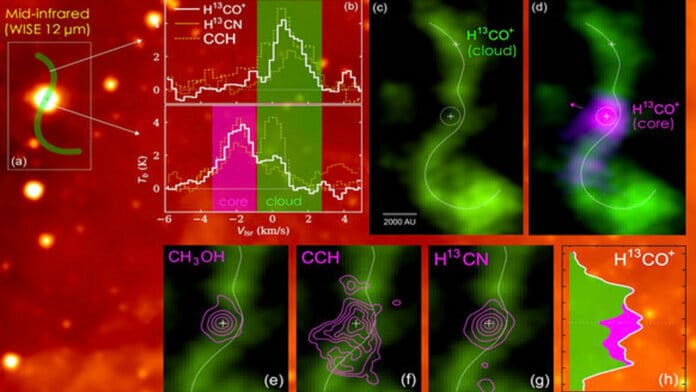Star-forming clouds can cause several prominent dynamical consequences. One is the escaping and spreading of young stars toward the surrounding space, which has caught increasing attention recently.
This is a crucial phase in the evolution of galaxies. Two explanations for stars escaping are proposed by theoretical research. First, interactions in young multiple-star systems may cause stars to be expelled. Second, when molecular clouds or clumps collide, they can acquire kinetic energy.
Typically, stars with comparatively distinct paths have entirely separated from their original location. On the other hand, young protostars are typically enmeshed deeply in molecular clouds, which makes measuring their kinematic characteristics challenging. Consequently, observational information about fleeing stars still needs to be improved.
However, utilizing high-resolution molecular spectral lines, a collaborative group of scientists from Guangzhou University, the Shanghai Observatory (SHAO) of the Chinese Academy of Sciences (CAS), and the National Astronomical Observatories (NAOC) of the CAS has now found the first instance of a protostar escaping from its birthplace, offering fresh observational proof for the early stage of running stars.
The researchers utilized the Atacama Large Millimeter/Submillimeter Antenna Array (ALMA) to conduct observations directed towards a sizable sample of regions still producing stars.
They discovered a protostellar core in the star-forming region G352.63-1.07 with a discernible velocity shift. Several molecular lines were found to exhibit the body, all of which suggested that the protostar’s velocity differed from that of its parent cloud. Simultaneously, the molecular lines closely follow the dense core, offering a unique chance to determine the stellar speed.
The protostar shows a notable blue shift of -2.3 km/s concerning its parental filamentary molecular cloud, as indicated by the spectral velocity of the molecular lines. In addition, the core’s exact position near the parental cloud’s central dip raises the possibility that it was formerly an integral component of the cloud.
The escape velocity (-2.3 km/s) and the spatial offset (0.025 light-years) of the core indicate that the escape had a kinetic energy of up to 1045 ergs and took place fewer than 4,000 years ago. Consequently, the core escape in G352.63-1.07 is among the most recent and intense occurrences in the Milky Way’s star-forming regions.
Furthermore, the escape velocity of the center star is comparable to the average dispersing rate of young stars, albeit significantly lower than that of high-speed ejection stars created in star clusters. This implies that the primary process pushing fleeing stars should be cloud collapse.
Prof. LI Di, the chief scientist of the Interstellar Medium Group of NAOC and co-author of the article, said, “Stars are giant nuclear fusion reactors in our universe. The escaping star discovered this time is still in its infancy. This work has snapshotted the initial moment of the stellar escaping motion in nearby active star-forming regions such as the Orion Molecular cloud. It enriches the picture of stellar origins and raises challenges.”
Scientists plan to conduct in-depth analyses of multi-star interactions and explosive gas expansion in G352.63-1.07.
Journal Reference:
- Zhiyuan Ren, Xi Chen, Tie Liu, et al. A High-mass, Young Star-forming Core Escaping from Its Parental Filament. The Astrophysical Journal. DOI 10.3847/1538-4357/aced54
